The next-gen MacBook Pro with Retina Display Review
by Anand Lal Shimpi on June 23, 2012 4:14 AM EST- Posted in
- Mac
- Apple
- MacBook Pro
- Laptops
- Notebooks
Last year when I wrote about the new MacBook Airs I offered two forward looking paragraphs:
What happens from here on out is what's really interesting. Intel has already committed to moving the TDP of its mainstream parts from 35W - 45W down to 10 - 20W. Since the Air is the new mainstream Mac notebook, Apple has already made that move. The performance in this 10 - 20W segment is going to get much better over the next two years, particularly once Haswell arrives.
The Thunderbolt Display is the first sign of what's to come. Moving IO controllers and expansion into the display, and potentially even moving discrete GPUs out of the notebook are all in store for us. Apple is really ahead of the curve here, but it's easy to imagine a future where laptops become a lot more like the new Air and shift to a couple high bandwidth ports instead of numerous lower bandwidth connections.
Perhaps I was being too aggressive in the prediction of a couple of high bandwidth ports. After all, the next-generation MacBook Pro with Retina Display features four such IO ports (2 x Thunderbolt and 2 x USB 3.0). But you get my point. Gigabit Ethernet and Firewire 800 are both gone. The discrete GPU is still present but I suspect even its days are numbered, at least inside the chassis. The personal computer as we knew it for so long, is changing.
The personal computer is getting thinner, lighter, more integrated and more appliance-like. The movement is no longer confined to just Apple either. The traditional PC OEMs are following suit. Even Microsoft has finally entered the PC hardware business, something it threatened to do for years but hadn't until now. Distribution models will change, the lines between different form factors will continue to blur. What was once a mature industry is going through a significant transformation. It’s exciting but at the same time it makes me uneasy. When I first got into this industry everyone had stories of companies with great ideas that just didn’t make it. As we go through this revolution in computing I’m beginning to see, first hand, the very same.
Apple makes the bulk of its revenue from devices that don’t look like traditional personal computers. For the past couple of years I’ve been worried that it would wake up and decide the traditional Mac is a burden, and it should instead be in the business of strictly selling consumer devices. With its announcements two weeks ago in San Francisco, I can happily say that my fears haven’t come true. At least not yet.
It’s been a while since Apple did a really exciting MacBook Pro launch. Much to my surprise, even the move to Sandy Bridge, the first quad-core in a MacBook Pro, was done without even whispers of a press conference. Apple threw up the new products on its online store, shipped inventory to its retail outlets, updated the website and called it a day. Every iPhone and iPad announcement however was accompanied with much fanfare. The MacBook Pro seemed almost forgotten.
With its WWDC unveil however Apple took something that it had resigned to unexciting, dare I say uncool status, and made a huge deal about it. Two weeks ago Apple did the expected and offered relatively modest upgrades to all of its portable Macs, all while introducing something bold.
Apple calls it the MacBook Pro with Retina Display. You’ll see me refer to it as the next-gen MacBook Pro, Retina MacBook Pro, rMBP or some other permutation of these words.
After using it for the past two weeks I can honestly say it’s the best Mac Apple has ever built. And there’s a lot more to it than hardware.
Portability
If you were hoping for a 15-inch MacBook Air, that’s not what the rMBP is. Instead it is a far more portable 15-inch MacBook Pro. I have to admit I was a bit let down the first time I laid eyes on the next-gen MacBook Pro, it looks good but it doesn’t look all that different. The disappointment quickly faded as I actually picked up the machine and started carrying it around. It’s not ultra light, but man does it make the previous chassis feel dated.
While I never really liked lugging around the old MBP (and it always made me feel like the old fogey at tradeshows where everyone else had something 13-inches or smaller), carrying the rMBP is a pleasure by comparison. Pictures really don’t do it justice. The impressively thin display assembly or overall chassis thickness look neat in a photo but it’s not until you actually live with the rMBP that you can appreciate what Apple has done here. I carry around a 15-inch MacBook Pro because it’s my desktop, and as such it’s incredibly useful to have with me when I travel. For my personal usage model, the Retina MacBook Pro is perfect.
If your workload demands that you need the performance of a MacBook Pro and your lifestyle requires you to carry it around a lot, the reduction in thickness and weight alone will be worth the upgrade to the rMBP. If you spend most of your time stationary however, you’ll have to be sold on the display and internal characteristics alone. The bad news is if the design doesn’t get you, everything else will.

From left to right: 11-inch MacBook Air, 13-inch MacBook Air, 15-inch MacBook Pro, MacBook Pro with Retina Display
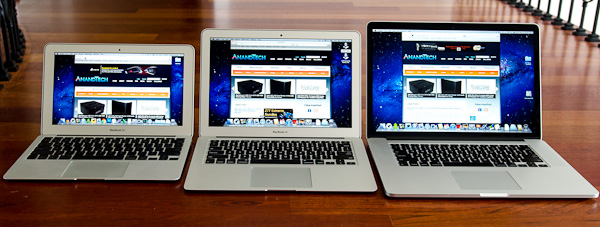
From left to right: 11-inch MacBook Air, 13-inch MacBook Air, MacBook Pro with Retina Display
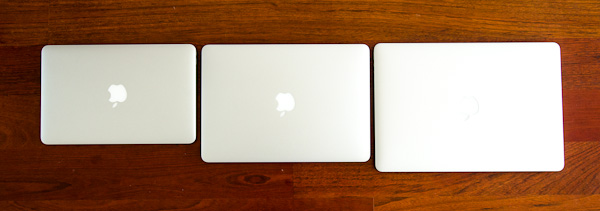
From left to right: 11-inch MacBook Air, 13-inch MacBook Air, MacBook Pro with Retina Display


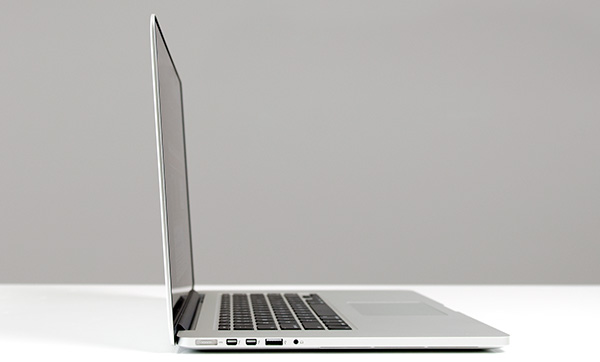
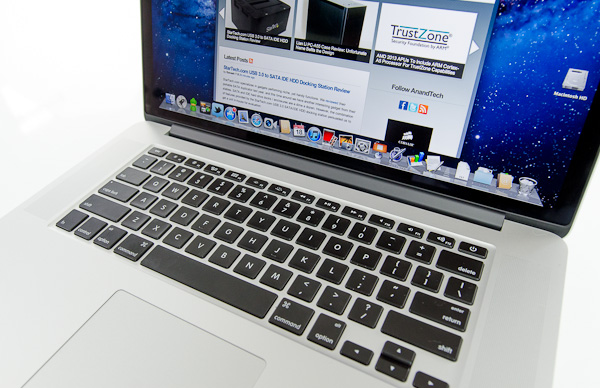
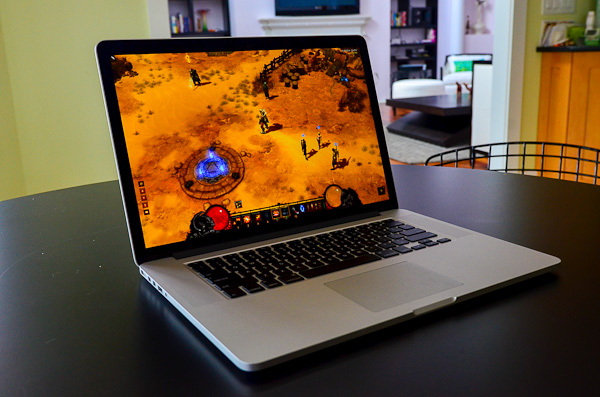
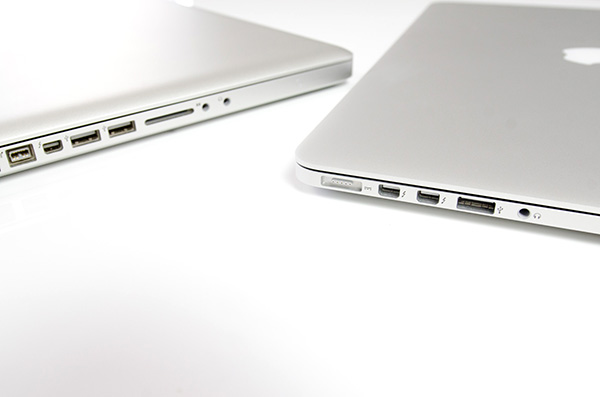
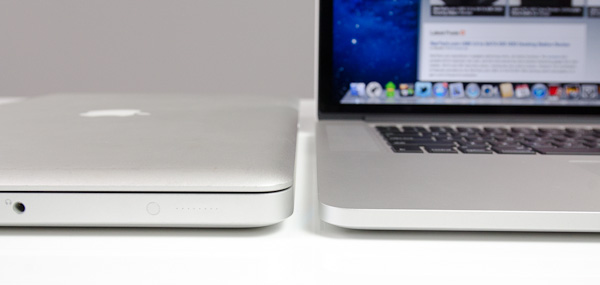








471 Comments
View All Comments
ciparis - Saturday, June 23, 2012 - link
Personally I'd much rather plug a single TB port into (for example) a TB monitor, which has a bunch of USB things plugged in, than plug in a bunch of USB things every time I move my laptop: point being, 2 USB is plenty for me -- I never want to be plugging that much crap into my laptop (even 2 gets annoying).DeciusStrabo - Sunday, June 24, 2012 - link
Even better would be a real dock instead of the half-backed version a Thunderbolt display gives you.dagamer34 - Sunday, June 24, 2012 - link
2 Thunderbolt docks: http://www.anandtech.com/show/5933/thunderbolt-doc...Only problem is price, but that will decrease over time.
Lepton87 - Saturday, June 23, 2012 - link
What's the point in using such a high resolution if 1920x1200 would be good enough to be called retina display? If you already can't see individual pixel, does it make a difference if you have a higher resolution? Seems like needless load on graphic card. Viewed from 17 inches on a 15'' panel 1920x1200 would be all that is needed to classify a screen "retina" anything higher than that seems like marketing and nothing else.UltraTech79 - Saturday, June 23, 2012 - link
Yeah guys, and whats the point in faster CPUs too? 486 is fast enough for most things if programmed right!hurrr
Lepton87 - Saturday, June 23, 2012 - link
Are you trolling or what? People already can't see individual pixels on a resolution of 1920x1200 on a 15'' panel. What do we accomplish by increasingPPI in on already retina display. And that's according to their own calculations involving PPI and the monitor monitor size and viewing distance. So, 1920x1200 15'' would also be retina and it would be far less consuming not only in therm's of graphic hardware but only CPU performance. Why was that not even in the article?
apple used a panel that has 2.35 more Pixel then a panel that would also be retina. So if both screens are of similar quality (ISP) and both are retina,why would someone pick the higher resolution screen. It just places unwarranted stress on GPU and CPU or components.
TL;DR
Why didn't they put IPS 1920x1200 panels. They also would be retina from normal viewing distance for laptons. 2880x1880 Seems like a huge wast of graphics performance and cpu as well.
jbwow - Saturday, June 23, 2012 - link
It is apparent from your comment that you have not actually seen the screen in question. You really can tell the difference. Instantly.Heathmoor - Friday, July 6, 2012 - link
The difference compared to what?wfolta - Saturday, June 23, 2012 - link
You can clearly see the difference, and in fact I tend to use my rMBP closer to me than I used my previous 17" MBP, precisely because it's so razor-sharp.Lepton87 - Saturday, June 23, 2012 - link
my previous 17" MBPYour previous 17'' had a much lower ppi then 15'' 1920x1200. I'm not saying that it's not an upgrade, all I'm saying this upgrade is a bit over the top. bit over the top. Previous resolution on apple screen were certainly to Small.
What irks me the most is that there exists a laptop with a higher resolution than my desktop monitor. even macbook LCD has a higher resolution than my desktop monitor. .